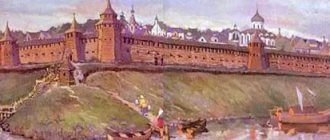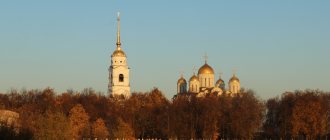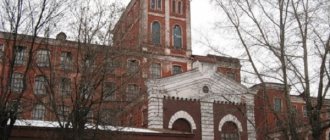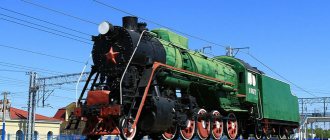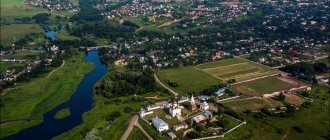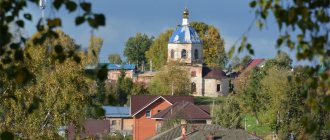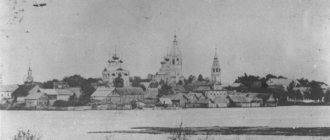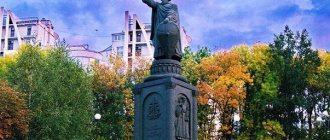| What to see on your own Monasteries Museums of Murom What to see in 1 day by car Stories, routes and tourist tips Where to stay in Murom Interesting excursions |
Murom - the name of this city is familiar to everyone who has read Russian fairy tales since childhood. This is one of the oldest cities in Russia, which dates back to 862, when it was first mentioned in the Tale of Bygone Years. Over its centuries-old history, the city served as an important outpost on the eastern borders of the country, and survived internecine wars, devastating raids, terrible fires, and troubled times. Murom is considered the birthplace of the famous epic hero Ilya Muromets; the fates of dozens of Orthodox saints are connected with the city, so thousands of pilgrims strive to visit its monasteries. The ancient city is rich in historical and cultural attractions.
Ilya Muromets
The most famous native of the Murom land is the epic hero Ilya Muromets, repeatedly mentioned in folklore not only of Russians, but also of neighboring peoples. The apparent contradiction of the previous sentence is deceptive. Many researchers consider Ilya Muromets to be a real historical character. And the collective story of his life is simply amazing. Everyone has heard about the hero’s exploits for the glory of the Russian land. But some details of his biography are not so well known.
The grandfather of Ilya Muromets was a convinced pagan. Once, in a fit of anger, he chopped up a Christian icon with an ax. The punishment fell on his grandson: Ilya could not walk since childhood, and all attempts to heal him were unsuccessful. The boy could only train his arms: his legs rested lifelessly on the stove. This continued until the age of 33 (the age of Christ!). Two “kalik passersby” (wandering beggars) entered his house and asked him to give them “intoxicating beer.” Ilya took their request as a mockery and said so. But the strange Kaliki were not embarrassed and repeated the request, which sounded more like an order.
Ilya, unexpectedly for himself... stood up and fulfilled the request. But the Kaliki did not drink, but ordered Ilya to do so, who after this felt great strength within himself. This can't happen? I agree, with only one addition: if we consider only the visible physical world to really exist. After all, the “Kalikas” who visited Ilya were...Christ with one of his apostles (as it was written in the pre-revolutionary editions of the epic about Ilya Muromets).
At the end of his life, Ilya Muromets decided to devote himself to God. He became a monk of the Kiev-Pechersk Monastery under the name of Elijah of the Pechersk. His relics rest in the Near Caves of the Lavra. Their study, conducted in 1988 by a commission of the Ministry of Health of Ukraine, gave results confirming the epic descriptions.
The relics belonged to a very physically strong man, approximately 50 years old, 1m 77 cm tall (in the 12th century, the average male height did not exceed 165 cm). He did suffer from polio in his youth, and his bones showed signs of many battles and blows with swords and spears, broken ribs and broken collarbones. Researchers named the cause of death as a blow to the chest from a sword or spear. It is assumed that this happened during the capture of Kyiv by Prince Rurik, when the Pechora Lavra was destroyed by the Polovtsians who were part of the prince’s army. In 1643, the Monk Ilya Muromets became a saint of the Russian Orthodox Church.
Stories, routes and tourist tips
Perhaps when planning a route around Murom for 2 days, you will need the experience of travelers who have already visited this city. Read the stories of tourists about trips at different times of the year, study the routes they took and make your own plan for exploring the sights that interest you. If you prefer traveling by car and are looking at where to go from Murom for 2 days, you should pay attention to the reports of car travelers who visited several cities along the way.
We recommend taking a look at the reviews of our Tourists:
- Review materials in the general Guide to Murom.
- Stories by Anna Murom or Journey to the Past and Monasteries of Murom.
- Maxim's story about visiting the homeland of Ilya Muromets How a hero came out of the city of Murom and from the village of Karacharovo.
- Dmitry's story about a road trip and meeting Murom on the way to Nizhny Novgorod.
All reviews about the trip to Murom on Tourister. RU
We also remind you that there is a “Questions and Answers” so that, if necessary, you can check with experts for up-to-date information about attractions or get advice on questions that interest you regarding your upcoming trip to Murom.
Ilya Muromets greets guests Photo: © Maria Penina
Village Karacharovo
The former village of Karacharovo is now a microdistrict of Murom. Its main attraction is house number 279 on the street. Priokskaya, where the hero was born and lived. Those living here today have no doubt that they are his direct descendants. Nearby is the Trinity Church, founded by the hero himself. The dilapidated building is now being restored, its bell tower with the chapel of Ilya Muromets has been restored.
Trinity Church
A nearby holy spring with a bath began to flow from the blow of the hooves of Ilya’s mighty horse.
Holy spring with bath
Karacharovo. Source of Elijah Muromets
After a walk to the wonderful and unusual Holy Lake, we returned to the glorious city of Murom. Our plans included another water feature. Namely, the source of St. Elijah of Murom, which should be located in the village of Karacharovo (now a suburb of Murom).
It was here that the epic hero and Orthodox saint was born and spent the first 33 years of his life motionless.
In Karacharovo there is a temple, which (according to stories) Ilya Muromets himself helped to build, and a chapel and a font were erected near the spring. Read more about this place here.
Annunciation Monastery Murom
Initially in the 12th century. on this site there was a wooden temple in which the spreaders of Christianity in Murom, princes Konstantin, Mikhail and Fedor, were buried. In honor of the capture of Kazan in 1553, Tsar Ivan the Terrible founded the Annunciation Monastery and the cathedral of the same name. The latter underwent a thorough reconstruction in the middle of the 17th century. The walls and baths of the monastery were also renewed in 1811. During the Patriotic War of 1812, the icons of the Iverskaya and Vladimir Mother of God were hidden in the monastery.
Annunciation Monastery Murom
Unlike many other churches, the closure of the monastery in 1919 can be considered conditional: the monks who moved to the city continued to serve there, and the relics of the saints were moved to local museums. During Soviet times, the Annunciation Cathedral in Murom was the only one functioning. The best 6-tier baroque iconostasis that has survived to this day also preserves icons from the 16th century. The entire monastery became fully operational again in 1991.
The icon of St. Elijah of Murom with a fragment of his relics is kept in the monastery, which was returned to believers in post-Soviet times and is still functioning.
Address - st. Krasnoarmeyskaya (formerly Uspenskaya), 16.
Best hotels in Murom
Related materials:
- 43 best attractions in Minsk,…
- 33 attractions of Bakhchisaray that are worth visiting
- 38 sights of Pskov recommended for…
- 31 attractions of Novorossiysk to visit
- 30 sights of Pereslavl-Zalessky,…
- 40 attractions in Limassol that are worth seeing
- 28 best sights of Uglich,…
- 41 attractions in Crete that are worth visiting
- 26 attractions of Svetlogorsk that…
Did you like the article? Share with friends:
1
Spaso-Preobrazhensky Monastery Murom
This monastery is one of the oldest and most famous in Rus'. According to documentary evidence, at the end of the 11th century. the son of Vladimir Monomakh was buried in it. The monastery arose around the estates of the first Murom prince Gleb. The initially wooden monastery was destroyed and burned by the Tatar-Mongols.
In the middle of the 14th century. the monastery was restored in stone. Two centuries later, the Transfiguration Cathedral was built nearby. Since then it has not undergone significant changes. During sieges, the cathedral assumed the functions of a fortress. Its facade is characterized by some severity, and its interior – asceticism.
Spaso-Preobrazhensky Monastery Murom
Another feature of the facade is the helmet-shaped (and not onion-shaped, as usual) domes. Subsequently, the monastery complex was replenished with the Church of the Intercession of the Virgin Mary with five chapels, a bell tower, a rectory, a religious school and outbuildings. Prince Peter, who accepted the schema, lived here, as is recalled by the bas-relief where he is depicted together with Fevronia, and the icon with scenes from their Life.
In 1918, the monks were accused of helping the White Guards, and the monastery was closed. Part of the monastery property became an exposition of the city museum. The premises of the monastery housed a factory, then a military unit.
In the 90s, the monastery was returned to believers. Now here, at the address st. Lakina, 1, there is a functioning monastery. In 2006, it was replenished with the image of Ilya of Muromets, made by a local carver according to the parameters obtained from studying the relics of Ilya of Pechersk.
Sights of Murom
Monasteries – there are quite a few of them here. They do not sparkle with domes or impress with huge churches. On the contrary, the Murom monasteries are cozy - they are not large and neat.
Religious buildings in the city coexist with Soviet buildings. Vladimir Ilyich on the square in front of the administration is always ready to lead us to the light or to the dark, as it suits you.
From such a neighborhood, Murom does not look like an ancient Russian city, rather it looks Soviet, I think I already talked about this.
Holy Trinity Monastery Murom
This convent on the site of a wooden church was built in the mid-17th century. financed by a local wealthy merchant. Its ensemble includes the five-domed Trinity Cathedral and the Kazan Gate Church with a bell tower.
Their interiors are decorated with tiles with images of herbs, birds and animals. The church and bell tower were erected on a single foundation. The slits of the facade and the lace decor give them lightness and airiness. The frames of many icons are decorated with skillful embroidery by gold-embroidery nuns.
Holy Trinity Monastery Murom
The monastery is primarily known as the burial place of the married couple of the Murom princes Peter and Fevronia, a monument to whom is installed in front of the entrance. Fevronia lived here after her monastic tonsure.
In worldly life, the princely married couple Peter and Fevronia won the love of their subjects with their righteous lives. They refused to help anyone, suppressed anger and cruelty, did not strive for worldly wealth, and glorified the name of God.
Peter and Fevronia, who naturally became monks in their old age, prayed daily to die at the same time and be buried in the same coffin with a thin partition. This was made during their lifetime. After Peter and Fevronia actually died on the same day and hour, their bodies were nevertheless placed in separate coffins in different monasteries, considering joint burial to be contrary to monastic traditions.
However, the next morning it turned out that the separate coffins were empty, and the bodies of Peter and Fevronia were reunited in the common coffin they had prepared. The next attempt to separate them after death was again unsuccessful. The people reconciled themselves to the will of God, and the couple were buried in the Nativity of the Mother of God Cathedral of the monastery. During the Soviet years it was closed, and the remains of the princes were transferred to the local museum. But the monastery was protected as an architectural monument. Since 1993, the relics returned to the church have been kept in the Trinity Cathedral.
Monument to Peter and Fevronia of Murom
The memory of the blessed princes Peter and Fevronia is celebrated annually on July 8. Since 2008, this date has been considered the Day of Family, Love and Fidelity. Wedding processions of newlyweds come to the monument to Peter and Fevronia every day in the hope that their marriage will be just as strong.
Since 1975, on the territory of the monastery there has been a wooden church of St. Sergius of Radonezh, transported from a nearby village, an architectural monument of the 18th century. It operates only in the summer. Since 2001, the Nadezhda boarding house has been opened at the monastery for minor girls and the elderly. The current address of the monastery is Peasant Square, 3 A.
Who would be interested in visiting Murom
You can find many reasons to visit the ancient city on the banks of the Oka.
You should come here to:
- better learn the history of Russia, look at the monuments of Russian architecture and architecture;
- visit ancient churches and monasteries;
- get acquainted with folk traditions during Christmas festivities, Maslenitsa, celebration of Family Day, love and fidelity;
- visit city museums, observation decks and picturesque parks;
- try a local delicacy - Russian rolls with filling, baked by monks.
Holy Resurrection Monastery Murom
On the northern outskirts of Murom, away from the main Murom attractions, is the Holy Resurrection Convent. A dirt road leads to it. The first mention of the monastery dates back to 1566. According to some information, it is the oldest Orthodox monastery in Russia. According to legend, it was founded by Prince Peter and his wife Fevronia). The latter lived here as a nun and died.
In the 17th century The wooden buildings of the monastery were replaced with stone ones. This is the five-domed Resurrection Cathedral and the Gate Church of the Vvedenskaya. But later the monastery was not lucky. It was closed by decree of Catherine II in 1764. The cathedral became a separate parish. During Soviet times, it was also closed, and the territory of the monastery was allocated for a sports complex. In 1998, the monastery was returned to the Russian Orthodox Church. At first the monastery was a courtyard of the Holy Trinity Monastery, but now it has restored its independence. Restoration work here continues to this day.
Holy Resurrection Monastery Murom
The five-domed Church of the Resurrection is the largest in Murom. Tall crosses shining in the sun give the building a festive look. The entrances are made in the form of old Russian tents. On the left is the Vvedenskaya Church with an octagonal hipped bell tower. It houses monastery relics and holds regular services. On the descent from the monastery to the Oka there is a healing spring named after. St. Peter and Fevronia.
Address – July lane, 1a.
Sudogodsky geyser (natural fountain). Homecoming
Our 3-day trip has come to an end. Almost everything planned was accomplished.
However, there was one point left in our program, which for some reason did not “yield” to us. We planned to visit a wonderful natural fountain on the way to Murom, not far from Sudogda. But neither the navigator nor the signs could help us find this secret place.
Therefore, I had to postpone visiting the Sudogodsky geyser until later. And now it has come: we are again passing by an amazing natural phenomenon. Will we be able to see this miracle, see here.
Nikolo-Embankment Church in Murom
Among the numerous Murom churches, the beautiful St. Nicholas Embankment Church, whose domes resemble the Holy Resurrection Monastery, is not lost. The church was built at the beginning of the 18th century. in the style of Peter the Great's Baroque. During the spring flood, the water is close to it, which is why the people call the church “Nikola Wet”. The church is named after Nicholas the Wonderworker, the patron saint of merchants and river travelers.
Nikolo-Embankment Church in Murom
The main shrine of the church is the relics of St. Juliania of Murom (Lazarevskaya - after the name of the village where she was originally buried), famous for her pious life and constant care for the disadvantaged. She could not pass by the suffering man indifferently. Being a noblewoman by birth and husband, she fed the hungry, cared for the sick, and sewed clothes for those who did not have them.
The church, closed in 1040, was returned to believers in 1992. The Nikolsky spring flowing near the church is considered healing.
The gilded domes of the church are depicted in many tourist materials about Murom.
At the foot of the church, the Nikolsky spring, considered healing, flows.
Address - st. Chuloshnikova, 27.
Church of St. Nicholas of the Embankment, relics of Juliana
Next to two wonderful monasteries: male and female, there is another wonderful church. Here, too, rest the relics of the wonderful holy righteous Juliana of Murom.
The Church of St. Nicholas the Mokroy or St. Nicholas of the Naberezhny is located on the high bank of the Oka. He seems to rise above the expanse. And below there is a holy spring and a bath. Read more here.
Church of St. Cosmas and Damian in Murom
Church of St. Kosma and Damian with a tent dome on the Embankment, built on the site of the tent of Ivan the Terrible, who was heading to the conquest of Kazan. After taking it, he fulfilled the vow he had made and erected a church. The name of the church is associated with the names of Christian healers - martyrs, in the Russian tradition called Kuzma and Demyan.
Church of St. Cosmas and Damian in Murom
According to another version, this was the name of two Murom residents - blacksmith brothers who secretly entered the Tatar camp and set it on fire, making the task easier for Ivan the Terrible. The brothers, however, died in the subsequent battle.
The 12-meter hipped dome of the church, which collapsed back in 1868, was restored only in 2009, and in wood. Research by restorers has shown that the ancient walls will not support the weight of the stone dome.
The best attractions in the vicinity of Murom
Karacharovo
Karacharovo
This is a picturesque village on the Oka coast, which, according to written sources, appeared in the 17th century. There are no modern buildings or developed infrastructure here. It was here that Ilya Muromets was born.
On the territory of the village there are many interesting assets: the Trinity Church, the Chapel, the temple of Guria and Aviva, the Hero's Spring.
Address: southern outskirts of Murom, Vladimir region.
Work schedule: 24 hours a day
Ticket price: free
Muromsky Bridge
Muromsky Bridge
The cable-stayed structure passing through the Oka connects two regions - Nizhny Novgorod and Vladimir. Its length is almost 1400 meters and its width reaches 15 meters.
This place is loved by tourists and locals thanks to its picturesque landscapes and panoramic views of the surrounding area. Wedding and themed photo shoots are often held here.
Address: Nizhny Novgorod region, P72
When to watch: any time
Epic stone
Epic stone
The historical monument is located at the exit from the city from Vladimir. It was erected in the middle of the last century.
Despite its nondescript and ordinary appearance, this place is considered one of the most visited among visiting tourists. They come to look at the unusual boulder, in which the architect conveyed the image of the famous hero.
Address: at the entrance to Murom along Vladimirskoye Highway
When to visit: any time
Church of the Smolensk Icon of the Mother of God
This church on the banks of the Oka is the Cathedral of Murom. The second name - Novokosmodemyanskaya, the church received after it was built in the 19th century. The church utensils of the collapsed Kosmodemyansk church were moved.
The Smolensk Church was built at the beginning of the 19th century. in the neoclassical style common in that period. A few decades later, the church was supplemented with a bell tower and a refectory.
Church of the Smolensk Icon of the Mother of God
In 1922, 24 kg of gold, a pound of silver and other valuables were taken from the church to help the starving people of the Volga region. The building was given over to an exhibition and concert hall.
The church, returned to believers in 1995, is located at st. Mechnikova, 1 (at the intersection with Gubkin St.).
Where to go in Murom, what else to see
Museum "Bread Room"
Museum "Bread Room"
The founders of the museum are employees of the Murom Baker organization. The museum has become an independent facility that hosts a wide variety of thematic events, programs, and exhibitions. The existing exhibitions are interactive.
City guests come here to watch the creative process. Those interested will be able to take part in master classes.
Address: Murom, Amosova street, 48
Working hours: every day from 9 am to 6 pm
Ticket price: from 150 rubles
Official website: https://hleb-gornica.ru/contacts
Armored train "Ilya Muromets"
Armored train "Ilya Muromets"
The armored train appeared during the Second World War. Ordinary people who did not have the proper experience worked on the creation. The armored train took an active part in hostilities and was able to withstand German military equipment. In the early 70s, it was decided to erect a monument to an armored train in a local park.
Tourists come to see the historical monument, which is made in real size and is very similar to a real armored train.
Address: Park named after the 50th anniversary of Soviet power
Church of the Smolensk Icon of the Mother of God
Church of the Smolensk Icon of the Mother of God
It was built on the site of a wooden church that burned down during a fire in the early 19th century. Later, a bell tower was erected and a refectory appeared. The architecture shows details of that time: arched elongated windows and doors, columns, pilasters with capitals. The building itself is made in a classical style.
Of interest is the temple itself, its appearance, arrangement and history.
Address: Murom, Mechnikova street, 1
Working hours: every day from 9.00 to 18.00, closed on Monday
Entry fee: free
Official website: https://smolenskaya.cerkov.ru/
Shopping arcades
Shopping arcades
Appeared at the beginning of the 19th century. At first glance, this is an inconspicuous and simple building. Huge columns and beautiful arches give it power and grandeur. Under the rows there are underground passages where grain was stored. This place has been repeatedly seen in many Russian films.
Tourists come to see the architecture of the building and walk through the rows, because trade is still carried out here.
Address: Murom, 1100th anniversary of Murom square, 2
Working hours: daily
Entry fee: free
Murom Historical and Art Museum
Murom Historical and Art Museum
Initially it was located in the Zvorykin House, where it existed for almost 70 years. In the early 90s, the presented exhibition objects and expositions were moved to a new location - the Golubev House.
The exhibition premises display ethnographic, ancient Russian and historical exhibits.
Address: Murom, Moskovskaya street, 13
Working hours: every day from 10 am to 6 pm
Ticket price: adult ticket - 100 rubles, children's ticket - 70 rubles, under 6 years old - free
Official website: https://museum-murom.ru/
Holy Cross Monastery
Holy Cross Monastery
According to reliable sources, the monastery was built back in the 13th century. At the end of the 19th century, a radical restructuring was carried out, and in the 30s of the last century it was blown up. Only in the 2000s did they decide to restore the former monastery on the site of motherwort and ruins. Outwardly, it has practically nothing in common with the former shrine.
The monastery can only be viewed from the outside; its architecture, which combines tent-roofed and Old Russian motifs, is of interest.
Address: Murom, Kranogvardeisky lane, 1b
Working Hours: External inspection available at any time
Ticket price: free
Oksky Park
Oksky Park
Also known as Lenin Park. This is a great place where you can just stroll and have fun with the whole family and experience the atmosphere of the 80s and 90s.
Previously, there were such famous assets as the Murom Kremlin and the Nativity Cathedral, which were destroyed. In the middle of the last century, the territory began to be equipped with walking alleys, attractions, and a dance floor.
Address: Murom, Pervomaiskaya street, 1
Work schedule: daily
Ticket price: free
Resurrection Women's Monastery
Resurrection Women's Monastery
The first information appeared in the 16th century. It is considered one of the largest in the city. In the 30s of the last century, the temple was closed and only 70 years later it was returned to the local Diocese. The complex of buildings is of interest: the five-domed Church of the Resurrection, on the territory of which a refectory, a gallery, and a tent-roofed bell tower have been preserved.
Address: Murom, July lane, 2
Working hours: from 8 am to 7 pm
Ticket price: free
Official website: https://svm-murom.ru/
Estate "Red Mountain" (Uvarov Estate)
Estate "Red Mountain" (Uvarov Estate)
Although the estate today is not in the best condition, it is still a significant asset of the city. Its first owners were the famous scientists and archaeologists Uvarovs. The building is decorated in light colors in classicism style.
Today, the main house, several outbuildings connected by galleries, and a small park have survived here.
Address: Murom, Kirova street, 2
Opening hours: 24 hours a day (only available for inspection from outside)
Ticket price: free
Muromsky Bridge over the Oka River
The cable-stayed bridge across the Oka was built in 2009 in the southern part of Murom. Its characteristics are impressive: length - 1.4 km, width - 15 m, height of supports along the banks and in the middle - 85 m, carrying capacity - 5 thousand vehicles per day. According to the results of the All-Russian competition in 2013, the bridge was named the best in Russia. The Vladimir-Arzamas bypass highway passes over the bridge, bypassing Murom.
Muromsky Bridge over the Oka River
Murom Hotels
The choice of hotels in Murom is much wider than in Elabuga and Yelets. Booking.com offers more than 30 accommodation options. The boss spent the night in Murom several times and, alas, has negative experience with Murom hotels. We warn readers against the Lada and Kremlevskaya hotels.
I will do a detailed analysis of the Murom hotels a little later. Here are only links with a minimum of comments.
Three heroes - 2,500 per night in a double room without breakfast. Breakfast - 300 rubles per person. Rating - 9.4!
Choose a room at the Three Bogatyrs hotel
Merchant's yard - 2,900 - 3,200 for a two-room apartment, breakfast at the same price, 300 rubles per person. The rating is slightly lower - 8.7. Perhaps because it's more expensive. After all, as soon as the price rises, so do expectations and requirements.
Choose a room in the retro hotel "Kupechesky Dvor"
AMOSOV - a bit far from the center. The best rating is 9.7! But very budget-friendly - from 1,700 to 2,500 for triple occupancy.
Choose a room at the AMOSOV hotel
I will not claim that I have fully covered the topic of Murom sights. Much is left beyond the scope of the article. We will be sincerely grateful to readers for additions and advice to travelers who included the ancient Russian city of Murom in their route.
Oka Garden
Once upon a time, on the territory of the current garden there was a dilapidated wooden Murom Kremlin, which in the 18th century. had to be taken apart. In the middle of the next century, on the initiative of the mayor, Prince Trubetskoy, it was decided to lay out a city garden in this place. Among the current vegetation of the garden, only elms have survived from that time. The garden located on a hill offers beautiful panoramas of the Oka and the city. The main buildings of the garden are the monument to Ilya Muromets and the fountain.
Monument to Ilya Muromets in Oka Garden
In the 21-meter monument, the sculptor Klykov embodied the two forms of Ilya Muromets - the defender of the Russian Land and the monk. In his right hand is a formidable sword, and in his left is a cross. A monastic robe is visible from under the chain mail. On the platform of the pedestal there are images of griffins - symbols of victory and power.
Monument to V.K. Zvorykin
Murom is proud of another of its natives - an outstanding scientist, one of the inventors of television - Vladimir Zvorykin. In 2013, near a merchant's house on the current street. Pervomaiskaya, 4, where Zvorykin was born and lived until 1919, a monument was erected. The Zvorykins' house is now the main building of the Murom Historical and Art Museum.
Monument to V.K. Zvorykin
After the fall of the government that patronized him, Kolchak decided to stay in the USA, where he was on a scientific trip. In this country he became a world famous scientist. At the same time, Zworykin visited the USSR many times, and even thought about returning to his homeland. Despite the fact that Murom was a city closed to foreigners, in 1967 Zvorykin and his wife surprisingly easily visited their native places, simply arriving by taxi from Vladimir.
The monument depicts young Zvorykin as he was during the Murom period of his life. His gaze is directed into the distance, as if seeing world fame and constant longing for Russia.
Museums of Murom in 1 day
The list of museums in Murom is small, but each of them is interesting and deserves attention. The oldest museum in the city is the Murom Historical and Art Museum. In the “Bread Room” you can find out where and when bread appeared, where the names “loaf”, “bun”, “Saika” and “kalach” came from, take part in the making of the Murom kalach and even paint freshly baked gingerbread with icing.
The most unusual is the interactive scientific and technical “Cyber Museum” , where you can go back in time. All types of computers dating back to 1981 are collected here, and they are in working order! You can play Dandy and write a program in BASIC, see vintage “suitcase” laptops, information storage devices from punch cards to flash drives and much more. The museum contains not only computer equipment, but also radio equipment, photographic equipment and household items from the USSR period.
Murom Historical and Art Museum
The modern Murom Historical and Art Museum is a complex of several buildings. The museum was opened in 1918 in the Zvorykin House (4 Pervomaiskaya St.). For seventy years, this mansion, built in the 1840s, was the only museum building. In 1987, the nearby building of the former city government, an architectural monument of the early 19th century, was transferred to the museum. The building housed an Art Gallery, where the exhibition “Russian and Western European Art of the 17th-20th Centuries” was opened, based on the collection of the Counts Uvarovs, which came to the museum from the estate in the village of Karacharovo.
In 1993, the Golubev House (Moskovskaya St., 13), built in the 1840s by the merchant of the third guild F.N. Cheparev, was transferred to the museum for the exhibition center. After a fire in 1859, the burnt house was bought by the merchant of the second guild D. L. Golubev, and until the revolution it was owned by his descendants. Temporary exhibitions were held in the building, and when the main museum building was closed for major renovations, an exhibition about the history of the city of the 18th–19th centuries and ancient Russian art was housed here.
Murom History and Art Museum Photo: © Anna Kudryavtseva
More information here: Murom Museums
Epic stone in Murom
Travelers entering the city from Vladimir are greeted by a massive block of stone with the face of Ilya Muromets and an incised quotation in Old Church Slavonic from the Chronicler Nestor’s Tale of Bygone Years with the first written mention of Murom dating back to 862.
Epic stone in Murom
Pine trees grow next to the stone, and this is no coincidence. After all, “There were three pine trees on the Murom path...”. A beautiful folk song returned to its roots, brilliantly performed by the inimitable Lydia Ruslanova, perfectly suits the spirit of the original Russian city.
If you are in the city of Murom, the editors of City-Sea magazine recommend that you visit the Ilya Muromets Theater-Museum - the only interactive theater in the city that tells the story of the hero Ilya Muromets. A special feature of the theater is its unique interactive theatrical performances, which include acting, various master classes and excursion programs. PROGRAMS IN THE THEATER-MUSEUM: - The Tale of the Hero Ilya Muromets; — Bogatyrsky secret; — Visiting a fairy tale. Pre-registration: 8-900-584-69-09
Murom, st. Kommunisticheskaya 33 Museum website: teatr-muzey-im.com
Murom City Day 2013
And we would like to rest in the evening after the righteous day's work. But it was not there. Unexpectedly, it turned out that today, August 3, the city of Murom celebrates its birthday.
It was very interesting to see how they do it. Moreover, even outside the windows of our monastery hotel one could hear the music coming from the Oka embankment.
Read about what we saw and how Murom residents celebrate City Day here.
